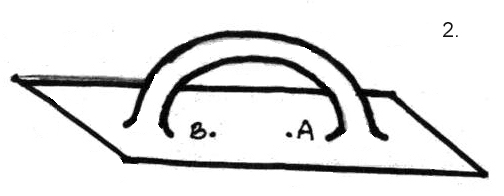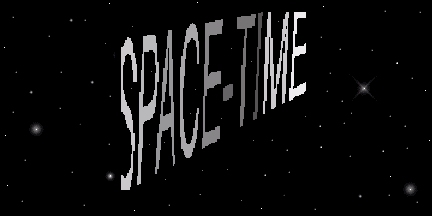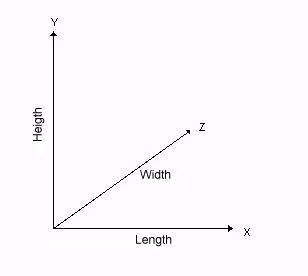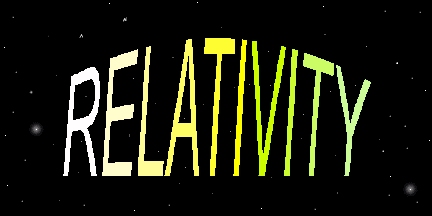Time Travel Research Center © 2005 Cetin BAL - GSM:+90 05366063183 - Turkey/Denizli
Along with parallel universes, wormholes are an extreme oddity whose existence is stated by relativity. But unlike parallel universes, there are no observations or vague experiments to give us proof that they're out there.
A wormhole is, simply, a tunnel through space-two 'mouths' connected by a throat. The mouths would be like black holes minus the singularity at the center so one could pass through. As for the structure of the tunnel... well, this is all theoretical. However, it is known that space-time behaves differently in a wormhole, so whether a wormhole looks like the longer path or not, it is the shortest distance between two points.

Wormholes sound like a great way for us to boost our space exploration program, but if they do exist, there's a major problem-they're sub-mircoscopic. In fact, many physicists theorize that space is made of 'space foam'- an unstable web of constantly appearing and disappearing wormholes. What would it take to make a wormhole travelable?
First of all, it would have to be enlarged and stabilized. To do this, we'd need to find a way to 'stretch space'. Once enlarged, the wormhole would have to be propped open with a so-called 'exotic material' that has an outward tension that equals the pressure at the center of the neutron star. (Recalling that neutron star is what collapses to form a black hole, you can imagine that kinds of pressure.) Then once we have a sizable and stable wormhole, we'd have to find away to move the ends so that they took us where we wanted to go. Obviously a shuttle with a trailer hitch is not going to accomplish this.
Supposing that we could accomplish this, we'd have the setup for the most classic of all science-fiction plots: Time Travel.
To accomplish this, one mouth of the wormhole would have to be accelerated at close to the speed of light until it was the desired amount of time behind the other mouth. (Remember, time moves more slowly as you move faster). If one entered the regular end, you would arrive 'back in time' at the accelerated end.
Time travel has its limits. One cannot travel back beyond the time when the wormhole was created. So to see the dinosaurs, we'd have to find a wormhole built by an ancient civilizatin from another planet.
The best way to see the limitations and possibilities of wormholes is to use the classic puzzel of going back in time to kill a parent before you were born. If you killed your father before you were born, you would not exist, so therefore you couldn't go back and kill him, but you DO exist... it seems like an endless loop. But now tie it in to the parallel universe theory-could a wormhole be a gateway to a parallel universe where you did kill your father? Or if not, how could you kill someone that already exists? If you traveled back in time, wouldn't you just be interacting with light signals?
The scientific community can explain wormholes, but the consequences of them are unknown. Should we ever create a functional one, it will certainly raise many new scientific and moral issues.

Diagram 1 exhibits the classic image of a wormhole in curved space-time. It seems obvious in this way that a wormhole is the shortest distance between points A and B. In diagram 2, it might seem as thought the wormhole would be longer, but space-time behaves differently in wormholes, so it would be the shortest distance, not the straight line.

Space-Time: Continuums & Curvature
Relativity views space-time as a continuum; that is, time becomes another dimension of space, making space four-dimensional. This is really common sense-we know that it takes time to move through the physical dimensions of space. (length, width, and heigth) Time is a property of space that is distinct from yet closely related to the other three. (Althought we know we can move through space in any direction, we can only move forward in time, at least until wormholes are discovered.)
Curvature of space-time can be more difficult to understand. Although the rubber sheet model gives a picture of how it happens, one cannot easily picture the so-called nothingness of space being curved or a non-physical property like time being warped. But relativity (a theory which has yet to be disproved) predicts this curvature and uses gravity as proof of it. In fact, relativity predicts singularities, points in space-time where the curvature reaches infinity. Singularities are the centers of black holes, points of gravity so strong that nothing, not even light, can escape.
According to relativity, the curvature of space-time is gravity, and this raises an intersting paradox: the amount of curvature is governed by the distribution of matter and energy in the univers, but this distribution is determined by the curvature of space-time. Thinking back to the rubber sheet model, this becomes an obvious truth. A large object, such as a shot put, would cause a large indentation that would cause a marble to roll in. Or, if an area of rubber sheet space contained only small objects, several marbles might roll together to form an area of 'strong gravity', which would in turn attract more objects.
Besides creating the all-important force of gravity, space-time curvature also makes a major dent (no pun intended) in one of our most common beliefs from geometry and family vacations: in curved space-time, a straight line is NOT always the shortest distance between two points. But that's a different topic.

In order to move through the physical dimensions of space, one must also move through time. In this graph, time surrounds the axes, and although the lines could be extended so that we could move in any physical direction, we do not extend them because we do not know how to move backwards in time.

Black holea re probably the most researched and best known of the topics dealing with relativity. Their existence has been speculated for over 200 years, but has yet to be proven.
A black hole is a region of space where gravity is so strong that nothing, not even light, can escape. (According to relativity, nothing can travel faster than light, so this makes sense.)
But what would cause this strong of a gravitational force? According astronomer John Michell in 1783, it would have to be the collapse of a massive star. And today we know that these massive stars exist-neutron stars.
A neutron star is the final phase of a star more than two times as large as the sun. The sun would collapse into a white dwarf-a dense, earth-sized ball of gas that can collapse no further due to the outward pressure of electrons spinning at near the speed of light.
But in a large star, the gravitational force is so strong that the electrons are pulled into the atomic nucleus where they combine with protons to form neutrons. A neutron star is small and unchanged-only a few miles in diameter. Then one of two things can happen.
That 'strong force'-the force that holds the atomic nucleus together can abruptly stop the implosion and cause the start to burst into a supernova. But if they star is more than two times the sun's size, nothing can stop its collapse into a small, dense object that traps even light- a black hole.
How does aone picture this in the rubber sheet model? Imagine placing an object so massive on the sheet that it cause its indentation to pinch off. This would cause the rest of the sheet to angle down towards the hole, and smaller objects would roll in towards this huge 'gravitational pull'.
Anatomy of a Black Hole...
Although black holes would seem the upitome of chaos, they have a definite structure, and it is even thought that the more matter and energy they pull in, the more ordered they become. (This distintly goes against Newton's Laws of Physics, but who's going to tell the black hole that?)
The outermost edge of a black hole is the event horizon, or Schwarzschild radius. It's the point at which the star collapsed into a black hole, and its size is therefore proportional to the star's mass.
That's the only definite part of a black hole. It used to be also generally agreed that there is a singularity at the center of a black holes where the laws of physics break down, but recently, Stephen Hawking, the leading expert on black holes, has begun to suspect that this may not be true.
Although black holes have the same structure, they are not all alike. Size varies greatly among black holes, with smaller ones causing more distortion of space-time; space-time would have to wrap itself more tightly around a smaller one to close it off. (Think of tine, extremely dense object being dropped on the rubber sheet.)
The physical difference with the most impact, though, is whether it is a rotating or non-rotating black hole. A still black hole is just as was discribed: event horizon, that singularity. But a rotating black hole has two even horizons, and makes some major differences.
Inside the first event horizon, it is just like a non-rotating black hole (the rotation, by the way, is from the rotation of the star before it collapses): gravity pulling you in faster and faster. But when you hit the second event horizon, it's like the eye of a storm: There is no singularity, and space-time seems to return to normal.
There is a problem, of course-there may be anti-gravity after the second event horizon, so you would be spit right back out. To where? Perhaps an alternate universe.
...And some other important schtuff
As was mentioned earlies, black holes are not known for sure to exist. But there may be one at the center of our galaxy, or in the binary system Cygnus X-1, 6000 light years from Earth.
Besides looking for the obvious area of 'nothingness' in space, there are other clues to the presence of one. In a binary system, one looks for accretion disks, a disk of gas that swirls into the suspected black hole from a neighboring star.
There is also the gravitational red shift. Longer light waves (red colors) have less energy. Photons of light will lose more and more energy as they try to escape the steadily stronger gravity of a black hole. The wavelengths lengthens until we must use radio and infrared telescopes to detect it, and then it either becomes to long to detect or it disappears.
The newest proof of black holes may be quasars-stars that radiate enough energy like an entire galaxy. These could be 'white holes', the opposite end of a black hole.
Black holes may have another way of being detected - Hawking Radiatin. Although nothing escapes from a black hole, Steven Hawking theorized that something must, because black holes have entropy. Anything with entropy must have a temperature, and anything with a temperature must emit radiation. The empty space around a black hole, he says, contains miniscule virtual particles that have positive and negative charges. Normally they combine to annhiliate each other. Sometimes the negative one will fall into the black hole, and the positively charged one will escape.
We have, been, plenty of proof that black holes exist. We just have yet to prove that they do exist. If the do, the all important question would be;
What happens when you fall into a black hole???
Good question. And there is two ways to look at it.
From the point of view of the person falling in, not much would change. You would feel fine, time would run normally, and life would be good. That is, until you began to be stretched apart by the difference in gravity between your head and feet. All parts of you body would be pulled towards the center of gravity, so you would be taffy before you reached the event horizon.
To the person watching you, this would not be the case. Say that you were sending singals back to the observer every second. To you, the singals would be sent out every second, but the closer you got the the event horizon, the longer they would take to reach the observer. The one sent out when you are at the event horizon can (ingnoring the fact that you would be dead) would never reach them. In fact, they would never see you reach the event horizon. Time at the event horizon is so slowed down according to the observers relative time, that you would seem to hang at the brink forever.
Black holes are still an unproven enigma, but their presence could lead to the discovery of an even more elusive theory-wormholes.

Parallel universes would seem to be the most unlikely prediction of relativity, but their proposal is just as fact-based as those dealing with black holes.
The idea of parallel universes was taken seriously after experiments with properties of light. Night exhibits wave-particle duality-it acts like both a particle and a wave. But even this odd characteristic did not account for the surprising results scientists noted in 'double slit tests'. A beam of light would be shined at a screen through another screen with two slits in it. When both slits were open, it seemed as if an electron would pass through both at the same time; and with one open, some areas of the screen would get more light then when both were open. While some of this could be attributed to particle-wave duality, in some cases it seemed almost as though the possibilities of what the light could do was affecting the outcome.
The only way for this to happen is for all the possiblities to exist at once. This idea is the backbone of the parallel universe theory-that all the possibilities for every action exist as an alternate universe. At the moment when an outcome is needed, they can overlap, or one of the separate universes will bend its solution.
Because there are an infinite number of possibilities, there is an infinite number of parallel universes, and therefore, an infinite number of you. A parallel universe for you oversleeping this morning, losing your homework, wearing different clothes... it goes on. For every interaction, there is a myriad of possibilites.
This all seems very far-fetched from Einstein's theory, but Einstein actually speculated and believed in parallel universes. He helped to discover the Einstein-Rosem Bridge-the area at the singularity of a rotating black hole where one can cross into a parallel universe.
Which is really the heart of the problem-reaching the singularity of a rotating black hole. But you'll have to read about black holes to find out why.

Einstein proposed two theories of relativity- Special Relativity in 1905, and General Relativity in 1915. Although general relativity is the theory that we will most closely consider in the following topics, Special Relativity is important to understand as it defines much of what we now consider basics of physics and sets a base for General Relativity.
Special Relativity is a theory on the nature of matter moving through space and time, and it combines these two properties into a continuum called Space-Time. The heart of the theory is that different observers moving at different rates of speed will find that the laws of physics and the speed of light remain the same, even though they will have different perceptions of time and distance. Because of this, simultaneous events can appear to happen at different times, or events happening hours apart to one person could happen at the same time to another. In other words, your reality is determined by your point of view.
Other important conclusions came from special relativity, including the fact that a moving object is shortened in the direction of movement, time runs more slowly for a moving object, no body can travel at or above the speed of light, and that a body has more mass when it is moving than when it is at rest. These effects are usually too small to be observed with our normal velocities.
Einstein's famous equation, E=mc², also stems from special relativity. The greater mass of a moving body suggests a connection between kinetic energy and mass. From there, Einstein guessed that all energy and mass would be related. E=mc² shows this relationship.
General Relativity is an extension of special relativity, but it is mainly a theory of gravity. It defines gravity as a curvature of the four-dimensional space-time suggested by special relativity.
The best way to picture this would be to imagine space-time as a rubber sheet. If you were to drop a lead ball onto the sheet, it would curve downwards. This indentation would be the ball's gravitational field. A heavier ball would create a larger 'field'. If you were to drop a marble or much lighter lead ball (because a very dense marble would create a 'field' of it's own!) Near one of the fields, it would roll in, much as a small celestial object would be pulled in by a larger one.
There are, of course, many other conclusions based on general relativity. General relativity gives a description of how material bodies will move in the presence of gravitational fields, and the mathematical equation gives the precise value for curvature caused by bodies of different masses. It predicts that extremely massive stars can collapse on themselves to form Black Holes. General relativity shows that gravity can bend light, such that some of the stars we see in the night sky are not readily visible to us, but the sun curves their light so we can see them. And finally, general relativity shows that a straight line is not always the shortest way between two points. A geodesic is what the line signifying this distance is known as. In Euclidean, or plane, geometry, the geodesic is a straight line. But when relativity comes into play, geodesics can become curved. (Think of the circle routes used by planes on long or overseas flights.)
Such are the basics of relativity. By the way, have you ever wondered why it's called relativity? It's because it all depends on the relative motion of the observers.
Web Page was created for the ThinkQuest Educational Homepage scholarship contest.
Hiçbir yazı/ resim izinsiz olarak kullanılamaz!! Telif hakları uyarınca bu bir suçtur..! Tüm hakları Çetin BAL' a aittir. Kaynak gösterilmek şartıyla siteden alıntı yapılabilir.
The Time Machine Project © 2005 Cetin BAL - GSM:+90 05366063183 -Turkiye/Denizli
Ana Sayfa /
index /Roket bilimi /![]() E-Mail /CetinBAL/Quantum Teleportation-2
E-Mail /CetinBAL/Quantum Teleportation-2
Time Travel Technology /Ziyaretçi Defteri /UFO Technology/Duyuru